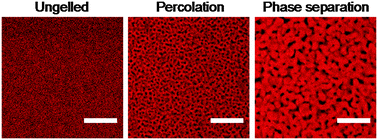Celebrating Soft Matter's 10th Anniversary: Sequential phase transitions in thermoresponsive nanoemulsions†
Abstract
We report the coexistence of stress-bearing percolation with arrested phase separation in a colloidal system of thermoresponsive nanoemulsions spanning a broad range of volume fractions (0.10 ≤ ϕ ≤ 0.33) and temperatures (22 °C ≤ T ≤ 65 °C). Here, gelation is driven by short-range interdroplet polymer bridging at elevated temperatures. Direct visualization of the gel microstructure shows that nanoemulsions undergo a homogenous percolation transition prior to phase separation. Rheological characterization shows that both the percolated and the phase separated structures are capable of supporting a significant amount of elastic stress. As the system is heated, the sequential onset of these phase transitions is responsible for the unusual two-step increase in the linear viscoelasticity of the gels. In addition, we find that slowing the heating rate significantly reduces the elasticity of the gels at high temperatures. Our results suggest that the formation of metastable gelled states not only depends on the attraction strength and volume fraction of the system, but is also sensitive to the rate at which the attraction strength is increased.

- This article is part of the themed collections: Soft Matter Lectureship Winners and Celebrating Soft Matter’s 10th Anniversary

 Please wait while we load your content...
Please wait while we load your content...